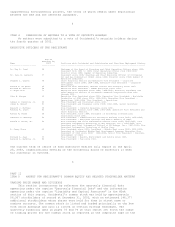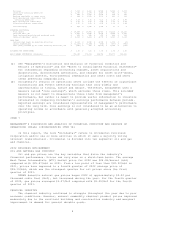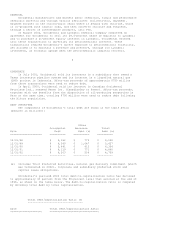Occidental Petroleum 2002 Annual Report Download - page 17
Download and view the complete annual report
Please find page 17 of the 2002 Occidental Petroleum annual report below. You can navigate through the pages in the report by either clicking on the pages listed below, or by using the keyword search tool below to find specific information within the annual report.historically experienced wide fluctuations within price cycles. For example, the
average price of WTI crude oil in the first quarter of 2002 was $21.64/bbl
compared to $28.15 in the fourth quarter. Although oil prices cannot be
predicted with any certainty, WTI price has averaged approximately $21.25/barrel
over the past ten years.
While supply-demand fundamentals are a decisive factor affecting domestic
natural gas prices over the long term, day-to-day prices may be more volatile in
the futures markets, such as on the NYMEX and other exchanges, which make it
difficult to predict prices with any degree of confidence.
Over the long-term, volatile prices, sharp production decline rates and the
uncertain timing of new gas supplies, in response to new gas-related drilling,
place constraints on the domestic gas supply industry. Record high gas-related
drilling rates in the first half of 2001 added very little new domestic
production capacity, increasing uncertainty about the 2003 gas supply outlook,
particularly as drilling declined in the wake of falling prices in the first
half of 2002.
The early onset of severe winter weather for the 2002-2003 heating season
contributed to an increase in gas prices in the second half of 2002. However,
this did not spark a corresponding increase in gas-driven drilling activity,
giving rise to expectations of steeper production decline rates in 2003. Robust
prices in 2003 could lead to a new upsurge in gas-related drilling to address
longer-term supply uncertainties.
13
CHEMICAL
The performance of the chemical business is difficult to forecast, but this
business is capable of contributing significant earnings and cash flow when
demand is strong. The major factors that have an impact on the performance of
the chemicals business are general economic conditions, energy and feedstock
costs, and the effect of changes in productive capacity.
CHLOR-ALKALI
Further improvement in ECU operating rates is expected as domestic demand
for both chlorine and caustic soda are forecasted to increase over 2 percent in
2003 and industry capacity is expected to decline further. PVC, and other
derivatives not manufactured by Occidental, are leading the growth in demand for
chlorine. Growth in demand for caustic soda is expected to track overall
manufacturing activity.
With increasing demand and increased capacity utilization, pricing for
chlorine is expected to improve slightly over the fourth quarter 2002 levels.
Caustic soda prices are expected to show a marked improvement over 2002 as
contracts reflect previously announced price increases and overall supply and
demand become more balanced.
Energy costs for 2003 are expected to increase over 2002 levels.
VINYLS
Occidental expects North American PVC resin demand to grow 4 - 5 percent
for 2003, based on annual U.S. and global GDP growth expectations of
approximately 2.5 percent. North American PVC operating rates are expected to
continue to move upward in 2003, averaging 1 - 2 percent higher than 2002 rates.
Chlorovinyls supply constraints, together with spiking energy costs, have
created conditions for vinyls price increases early in 2003. In addition, VCM
intermediates will be in shorter supply than PVC because of industry capacity
rationalizations and maintenance requirements. Operating rates for North
American VCM producers are expected to average well above 90 percent.
Energy and raw material price escalation will limit margin growth in 2003.
Tightness in chlorine supply for vinyls production will remain a concern in
2003.
INCOME SUMMARY
Occidental reported net income of $1.0 billion ($2.63 per share) in 2002,
on net sales of $7.3 billion, compared with net income of $1.2 billion ($3.10
per share) in 2001, on net sales of $8.1 billion. Core earnings were $1.0
billion in 2002 and $1.2 billion in 2001.
























